911B.00
Anuncio
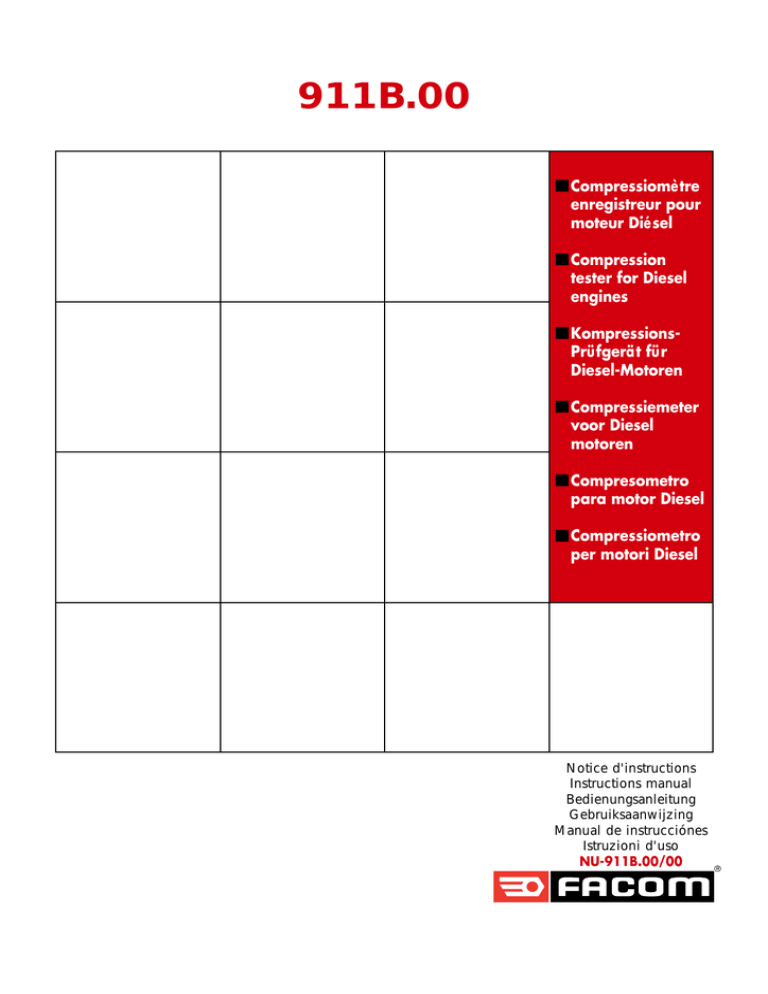
911B.00 ■ Compressiomètre enregistreur pour moteur Diésel ■ Compression tester for Diesel engines ■ KompressionsPrüfgerät für Diesel-Motoren ■ Compressiemeter voor Diesel motoren ■ Compresometro para motor Diesel ■ Compressiometro per motori Diesel Notice d'instructions Instructions manual Bedienungsanleitung Gebruiksaanwijzing Manual de instrucciónes Istruzioni d'uso NU-911B.00/00 Fig 1 F CARACTÉRISTIQUES 911B.00 Longueur = 240 mm Largeur Poids Echelle du graphique Graduation Longueur du flexible Longueur du cordon de démarrage Nombre de courbes enregistrées Largeur de la courbe Coffret BV.911B = = = = = = = = = 1 2 90 mm 1,1 Kg 5 à 60 bar 2,5 bar 360 mm 1850 mm 12 (cylindres possibles) 60 mm 430 x 340 x 85 mm 4 DESCRIPTION 1 2 3 4 5 6 7 8 9 - Renvoi d'angle réf : 911B.017 Fausses bougies Bouton de décompression Faux injecteurs Flexible réf : 911B.SE2 Cordon de démarrage réf : 911B.016 100 fiches graphiques réf : 911B.FC Interrupteur de commande du démarreur Levier d'avance de la fiche graphique UTILISATION 1 - Préparation du compressiomètre Insérer une fiche graphique vierge sur la table d'enregistrement fig 2. Pousser la table à fond. Brancher le cordon de démarrage en dessous de la poignée de l'appareil. 2 - Préparation du moteur Le moteur doit être chaud et la batterie en bon état. Neutraliser l'arrivée de gazole. Déposer tout les injecteurs ou les bougies de préchauffage. Donner un coup de démarreur (attention aux joints et rondelles) pour éliminer les particules de calamine. Brancher le cordon de démarrage comme indiqué fig 3. 3 - Contrôle de la compression d'un cylindre Monter un faux injecteur (ou une fausse bougie) correspondant au modèle d'injecteur (ou de la bougie) monté sur le cylindre N°1. Voir le tableau d'affectations page 7. Visser le raccord de l'appareil sur le faux injecteur (ou sur la fausse bougie). Dans les cas d'accès difficiles, intercaler le renvoi d'angle entre le flexible et le raccord. Faire tourner le moteur en actionnant le démarreur avec le bouton repère 8 situé sur la poignée. Observer l'aiguille ; lorsqu'elle est stabilisée au maximum de sa déviation, arrêter l'essai. Décompresser en appuyant sur le bouton repère 3 situé à droite. L'aiguille revient à zéro, il est alors possible de démonter le raccord du faux injecteur (ou de la fausse bougie). 4 - Contrôle des compressions des autres cylindres Après avoir avec le levier, avancé d'un cran la fiche graphique. Recommencer l'opération "3" sur les autres cylindres. 5 - Analyse des résultats Pendant le contrôle, une montée rapide de l'aiguille est le signe d'une bonne étanchéité au niveau de la segmentation, des soupapes et du joint de culasse. Le graphique enregistré indique la valeur de la pression en fin de compression dans chaque cylindre contrôlé. Les valeurs nominales et leur tolérances sont indiquées dans les manuels de constructeurs ou les éditions techniques de spécialistes. Pour trouver ou se situe une fuite, utiliser le détecteur de fuite FACOM référence 910A + 910.06. ENTRETIEN Maintenir l'appareil propre, nettoyer périodiquement les filetages des faux injecteurs et des fausses bougies. En France, pour tous renseignements techniques sur l'outillage à main, téléphonez au 01 64 54 45 14 6 911B.00 5 Fig 2 7 8 9 3 Fig 3 6 GB D SPECIFICATIONS 911B.00 Length = 240 mm Width = 90 mm Weight = 1.1 kg Scale of diagram = 5 - 60 bar Graduation = 2.5 bar Length of hose = 360 mm Length of starter cord = 1850 mm Number of curves recorded = 12 (possible cylinders) Width of curve = 60 mm Case BV.911B = 430 x 340 x 85mm DESCRIPTION 1 - Bevel gear ref : 911B.017 2 - Dummy plugs 3 - Decompression button 4 - Dummy nozzles 5 - Hose ref : 911B.SE2 6 - Starter cord ref : 911B.016 7 - 100 diagram cards ref : 911B.FC 8 - Starter control circuit-breaker 9 - Diagram card feed lever KENNDATEN 911B.00 Länge = 240 mm Breite = 90 mm Gewicht = 1,1 kg Anzeigebereich = 5 bis 60 bar Graduierung = 2,5 bar Schlauchlänge = 360 mm Startschnurlänge = 1850 mm Anzahl der aufgezeichneten Kurven = 12 (Zylinder möglich) Kurvenbreite = 60 mm Koffer BV.911B = 430 x 340 x 85 mm BESCHREIBUNG 1 - Winkelumlenkung Art. Nr. 911B.017 2 - Blindkerzen 3 - Dekompressionsknopf 4 - Blindinjektoren 5 - Schlauch Art. Nr. 911B.SE2 6 - Startschnur Art. Nr. 911B.016 7 - 100 Graphikkarten Art. Nr. 911B.FC 8 - Starter-Bedienschalter 9 - Vorschubhebel für Graphikkarte APPLICATION 1 - Preparing the compressometer Insert a new diagram card into the recording table fig 2. Push the table right in. Plug in the starter cord under the handle of the apparatus. 2 - Preparing the motor The motor should be warm and the battery in good condition. Neutralize the fuel intake. Remove all the warm-up nozzles and plugs. Pull the starter cord (careful of the joints and washers) to get rid of any scale. Plug the starter cord in as in fig 3. 3 - Checking the compression in a cylinder Fit a dummy nozzle (or dummy plug) corresponding to the kind of nozzle (or plug) fitted on cylinder N°1. See table of allocations page 7. Screw the connector of the apparatus onto the dummy nozzle (or dummy plug). If this is hard to reach, insert the bevel gear between the hose and the connector. Turn the motor over while pressing the starter button index 8 located on the handle. Watch the needle ; when it stabilises at its maximum deviation, stop testing. Decompress by pushing button index 3 located on the right. The needle will drop back to zero, and the connector can then be removed from the dummy nozzle (or dummy plug). 4 - Checking the compression of the other cylinders After moving the diagram card on a notch using the lever, begin operation "3" with the other cylinders. 5 - Analysis of the results During the check, if the needle rises rapidly it signifies that the rings, valves and cylinder head joint are airtight. The recorded diagram shows the pressure at the end of compression in each cylinder checked. The nominal values and their tolerances are indicated in the manufacturers’ manuals or specialist technical publications. To locate a leak, use the FACOM leak detector ref. 910A + 910.06. EINSATZ 1 - Vorbereitung des Drucksetzungsmessers Eine leere Graphikkarte auf die Aufzeichnungsfläche fig 2 legen. Die Platte ganz hineinschieben. Die Startschnur unter dem Griff des Geräts anschließen. 2 - Vorbereitung des Motors Der Motor muß warm, die Batterie in gutem Zustand sein. Dieselzufuhr absperren. Alle Injektoren oder Vorheizkerzen entfernen. Den Starter betätigen (Vorsicht mit den Dichtungen und Unterlegscheiben), um Zunderpartikel zu eliminieren. Die Startschnur wie in fig 3 dargestellt anschließen. 3 - Kontrolle der Kompression eines Zylinders Einen entsprechenden Blindinjektor (oder eine Blindkerze), der dem Injektormodell (oder dem der Kerze) des Zylinders Nr. 1 entspricht, einsetzen. Siehe Tabelle der Zuweisungen Seite 7. Den Anschluß des Geräts auf den Blindinjektor schrauben (oder auf die Blindkerze). Ist die Stelle schwer zugänglich, gibt man die Winkelumlenkung zwischen Schlauch und Anschluß. Den Motor durch Betätigen des Starters mit dem Knopf Nr. 8 auf dem Griff drehen lassen. Die Nadel beobachten : sobald sie auf dem Maximum ihres Ausschlags stillsteht, den Versuch stoppen. Mit dem Knopf Nr. 3 (rechts) den Druck vermindern. Die Nadel fällt auf Null zurück. Jetzt kann man den Anschluß des Blindinjektors (oder der Blindkerze) demontieren. 4 - Kontrolle der Drucksetzung der anderen Zylinder Nach dem Weiterdrehen der Graphikkarte um ein Maß mit dem Hebel, beginnt man den Vorgang "3" an den anderen Zylindern. 5 - Analyse der Ergebnisse Während der Kontrolle, bedeutet ein rasches Ansteigen der Nadel eine gute Dichtheit auf der Ebene der Segmentierung, der Ventile und der Zylinderkopfdichtung. Die aufgezeichnete Graphik zeigt den Druckwert am Ende der Beaufschlagung in jedem geprüften Zylinder an. Die Nennwerte und ihre Toleranzen sind in den Hersteller-Handbüchern oder den technischen Herausgaben der Spezialisten enthalten. Um ein Leck zu orten, benutzt man einen FACOM-Leck-Detektor Art. Nr. 910A +910.06. INSTANDHALTUNG Das Gerät sauber halten, regelmäßig die Gewinde der Blindinjektoren und Blindkerzen reinigen. MAINTENANCE Keep the apparatus clean, periodically clean the screw threads on the dummy nozzles and dummy plugs. NL TECHNISCHE GEGEVENS 911B.OO Lengte = 240 mm Breedte = 90 mm Gewicht = 1,1 kg Schaal = 5 tot 60 bar Schaalverdeling = 2,5 bar Lengte slang = 360 mm Lengte startkabel = 1850 mm Aantal weergegeven curven = 12 (max. aantal cilinders) Breedte van de curve = 60 mm Koffertje BV.911B = 430x340x85 mm INHOUD 1. Haakse overbrenging bestelnr. 911B.017 2. Testgloeibougies 3. Decompressieknop 4. Test-inspuitmondstukken 5. Slang bestelnr. 911B.SE2 6. Startkabel bestelnr. 911B.016 7. 100 meetkaartjes bestelnr. 911B.FC 8. Bedieningsschakelaar startmotor 9. Afstelhefboom meetkaart GEBRUIKSAANWIJZING 1 - Compressiemeter klaarmaken voor gebruik Breng een meetkaartje aan in papierinvoer fig 2. Duw de papierinvoer naar achteren. Sluit de startkabel aan onder de handgreep van het apparaat. 2 - Voorbereiding aan de motor De motor dient warm te zijn en de accu in goede staat te verkeren. Stop de gasolietoevoer. Verwijder alle inspuitstukken of alle gloeibougies. Laat de startmotor even draaien (let op koppelingen en ringen) om de kooldeeltjes te verwijderen. Sluit de startkabel aan zoals aangegeven staat in fig 3. 3 - Controle van de druk in een cilinder Monteer een test-inspuitstuk (of een testgloeibougie) met de vorm van het inspuitstuk (of de gloeibougie) die op cilinder nr.1 hoort. Zie de toepassingstabel blz. 7. Draai het aansluitstuk van het apparaat op het test-inspuitstuk (of de testgloeibougie). Wanneer dit moeilijk gaat, plaatst u de haakse overbrenging tussen slang en aansluitstuk. Laat de motor draaien door de startmotor in te schakelen door middel van knop 8 op de handgreep. Let op de wijzer : wanneer deze op de maximale uitslag blijft staan, beëindigt u de test. Verminder de druk door op knop nr 3, rechts op het apparaat, te drukken. De wijzer zakt terug naar nul, waarna u het aansluitstuk met het test-inspuitstuk (of de gloeibougie) kunt verwijderen. 4 - Controle van de druk in de overige cilinders Nadat u het meetkaartje heeft doorgedraaid, gaat u voor de overige cilinders te werk zoals hierboven bij punt "3" staat omschreven. 5 - Analyse van de testresultaten Wanneer de wijzer tijdens de test snel opklimt, is de afdichting van zuigerveren, de kleppen en de koppakking goed in orde. De gemaakte grafiek geeft de druk weer die aan het eind van de compressiefase in elke cilinder bestaat. De nominale waarden en de toegestane afwijkingen staan aangegeven in fabriekshandboeken of in technische specialistische uitgaven. Om een lek te ontdekken, dient u de FACOM-lekdetector te gebruiken, bestelnr. 910A + 910.06. ONDERHOUD Laat het apparaat niet vuil worden en maak regelmatig de schroefdraad schoon van de test-inspuitstukken en de testgloeibougies. Fig 1 1 2 4 6 911B.00 5 Fig 2 7 8 9 3 Fig 3 6 E CARACTERISTICAS 911B.00 Longitud = 240 mm Anchura = 90 mm Peso = 1,1 kg. Escala del gráfico = de 5 a 60 bares Graduación = 2,5 bares Longitud del tubo flexible = 360 mm Longitud del cable de arranque = 1850 mm Número de curvas registradas = 12 (cilindros posibles) Anchura de la curva = 60 mm Caja BV.911B = 430 x 340 x 85 mm DESCRIPCION 1 . Transmisión angular ref : 911B.017 2 . Falsas bujías 3 . Botón de descompresión 4 . Falsos inyectores 5 . Tubo flexible ref : 911B.SE2 6 . Cable de arranque ref : 911B.016 7 . 100 fichas gráficas ref : 911B.FC 8 . Interruptor de mando del motor de arranque 9 . Palanca de avance de la ficha gráfica UTILIZACION 1 - Preparación del compresiómetro Insertar una ficha gráfica virgen en la mesa de registro fig 2. Empujar la mesa a fondo. Conectar el cable de arranque por debajo del asa del aparato. 2 - Preparación del motor El motor debe estar caliente y la batería en buen estado. Neutralizar la llegada de gasoil. Poner todos los inyectores o las bujías de precalentamiento. Hacer funcionar brevemente el motor de arranque (atención a las juntas y arandelas) para eliminar las partículas de calamina. Conectar el cable de arranque como se indica en la fig 3. 3 - Control de la compresión de un cilindro Montar un falso inyector (o una falsa bujía) que corresponda al modelo de inyector (o de la bujía) montado en el cilindro Nº 1. Ver el cuadro de asignaciones page 7. Enroscar el racor del aparato en el falso inyector (o en la falsa bujía). En los casos de accesos difíciles, intercalar la transmisión angular entre el tubo flexible y el racor. Hacer funcionar el motor accionando el motor de arranque con el botón indicación 8 situado en la empunadura. Observar la aguja y cuando esté estabilizada al máximo de su desviación, parar la prueba. Despresurizar pulsando el botón indicación 3 situado a la derecha. La aguja vuelve a cero y, entonces, es posible desmontar el racor del falso inyector (o de la falsa bujía). 4 - Control de las compresiones de los demás cilindros Después de haber hecho avanzar una muesca la ficha gráfica con la palanca, comenzar la operación "3" en los demás cilindros. 5 - Análisis de los resultados Durante el control, una subida rápida de la aguja es el signo de una buena estanqueidad a nivel de la segmentación, de las válvulas y de la junta de culata. El gráfico registrado indica el valor de la presión al final de la compresión en cada cilindro controlado. Los valores nominales y sus tolerancias se indican en los manuales de los constructores o en las ediciones técnicas de especialistas. Para encontrar dónde se sitúa una fuga, utilizar el detector de fugas FACOM referencia 910A + 910.06 MANTENIMIENTO Mantener el aparato limpio. Limpiar periódicamente los roscados de los falsos inyectores y de las falsas bujías. I CARATTERISTICHE 911B.00 Lunghezza = 240 mm Larghezza = 90 mm Peso = 1,1 kg Scala del grafico = da 5 a 60 bar Graduazione = 2,5 bar Lunghezza del cavo flessibile = 360 mm Lunghezza del cavo d’avviamento = 1850 mm Numero delle curve registrate = 12 (cilindri possibili) Larghezza della curva = 60 mm Valigetta BV.911B = 430x340x85 mm DESCRIZIONE 1 - Rinvio angolare rif : 911B.017 2 - False candele 3 - Pulsante di decompressione 4 - Falsi iniettori 5 - Cavo flessibile fig : 911B.SE2 6 - Cavo d’avviamento rif : 911B.016 7 - 100 schede grafiche rif : 911B.FC 8 - Interruttore di comando avviamento 9 - Leva di avanzamento della scheda grafica UTILIZZO 1 - Preparazione del compressiometro Inserire una scheda grafica vergine sul piano di registrazione fig 2. Spingere il piano a fondo. Collegare il cavo di avviamento sotto l’impugnatura dell’apparecchio. 2 - Preparazione del motore Il motore deve essere caldo e la batteria in buone condizioni. Chiudere l’alimentazione di gasolio. Togliere tutti gli iniettori o le candele di preriscaldo. Dare un colpo di avviamento (attenzione ai giunti e alle rondelle) per eliminare le particelle di incrostazione. Collegare il cavo di avviamento come indicato nella fig 3. 3 - Controllo della compressione di un cilindro Montare un falso iniettore (o una falsa candela) corrispondente al modello dell’iniettore (o della candela) montato sul cilindro n° 1. Si veda la tabella erogazioni pagina 7. Avvitare il raccordo dell’apparecchio sul falso iniettore (o sulla falsa candela). In caso di accesso difficile, inserire il rinvio angolare fra il cavo flessibile e il raccordo. Fare girare il motore azionando l’avviamento con il pulsante riferimento 8 posto sull’impugnatura. Osservare l’ago : quando quest’ultimo si stabilizza sul massimo della sua deviazione, sospendere la prova. Esercitare una decompressione, agendo sul pulsante riferimento 3 situato a destra. L’ago torna a zero ed è quindi possibile smontare il raccordo del falso iniettore (o delle false candele). 4 - Controllo delle compressioni degli altri cilindri Dopo aver fatto avanzare la scheda grafica di una tacca con l’ausilio della leva, ripetere l’operazione "3" sugli altri cilindri. 5 - Analisi dei risultati Durante il controllo, un’impennata rapida dell’ago indica una buona tenuta a livello della segmentazione, delle valvole e delle guarnizioni delle teste cilindri. Il grafico registrato indica il valore della pressione alla fine della compressione su ogni cilindro controllato. I valori nominali e le loro tolleranze sono indicati nei manuali dei costruttori o nelle edizioni tecniche specializzate. Per individuare dove si torva una perdita, utilizzare il rilevatore di perdite FACOM riferimento 910A + 910.06. MANUTENZIONE Mantenere l’apparecchio pulito e pulire periodicamente le filettature dei falsi iniettori e delle false candele. Pièces détachées Onderdelen - Spare parts - Piezas de recambios - Ersatzteile - Pezzi di recambio 1 2 6 4 8 5 9 12 7 3 11 10 1 2 3 4 5 6 911B.00 911B.012 911B.016 911B.017 911B.0023 911B.033 911B.FC 100 7 8 9 10 11 12 911B.RN1 911B.RN2 911B.SE1 911B.SE2 911B.SE3 911B.SE5 AFFECTATIONS TOEPASSINGEN - APPLICATIONS - DESIGNACIONES - ZUORDNUNG - APPLICAZIONE Réf DIESEL 911B.018 CITROËN CX25D - FIAT 242D - FORD Granada D - PEUGEOT J5D RENAULT Fuego D - VOLKSWAGEN Santana D ALFA ROMEO 75TD2,0 - FIAT Ritmo D - FORD Granada D (80➞) - Transit D (81➞83) LANCIA Thema D - RENAULT 18D - 20D - 30D - Master - ROVER 2400D - SEAT Ibiza CLX TD (92) - Malaga 1,7XL AUDI 80TD - BMW 324D - 524D - CITROËN BX D - Visa D - Jumper 1,9D & TD FIAT Uno 1,4TD & 1,6DS - Tipo 1,7TD - Fiorino 1,7D - Punto STD - Tempra 1,9D & TDS - Croma D FORD Fiesta 1,8D - TD - Escort 1,8D - Livraison D - Sierra 1,8TD & CLX TD - Mondeo 1,8 NISSAN Sunny 2,0D SLX - Primera 2,0D LX - Serena 2,0D LX - Vanette pratic 2,0 - LANCIA D MERCEDES 190D - 200D - 220D - 240D - 300D - OPEL Astra 1,7D & TD - Omega 2,3TD PEUGEOT 305 - 505 - 604D - Boxer 1,9D & TD - RENAULT Clio 1,9TD - R19 GTD - Express 1,6D ROVER 218 GSD - SEAT Toledo CL 1,9D - Cordoba CLX1,9 - Ibiza (93) - VOLVO 240 à 760D VOLKSWAGEN Polo - Golf TD & GTD - Caravelle 2,4 - Passat TD - Vento TD - Transporter 1,9D CITROËN AX14D - ZX1,9D & TD - BX19TGD - Xantia 1,9D & TD - XMD & DT - C15D - Jumpy 1,9TD FORD Scorpio 2,5TD - LANCIA Delta - MAZDA 626 2,0D NISSAN Patrol LX - OPEL Vectra 1,7D - Reckord - Ascona - PEUGEOT 106 XTD (➞I95) - 205 GRD & TD - 306 D 309 SRDT - 405 GRD & SRD - 605 SVDT - RENAULT R21 1,9 & 2,1 GTD - Safrane 2,1TD ROVER 114 - SEAT Ibiza 1,7D - Ronda D - Malaga D ALFA ROMEO A12D - A13D - Guilia D FORD Transit D (except, behalve : 2,5L) - MERCEDES 190D2,5 - PEUGEOT 306 TD - J5 TD2,5 RENAULT R25TD - Espace 3 TD - Trafic 1,4 - ROVER Land Rover Sherpa D FIAT (anciens modèles - early models - oude modelen) BMW 324TD (92) - 325TD (92) - 524TD (92) - 525TD & TDS (92) - RENAULT Safrane 2,5TD MERCEDES 190 D & TD - 200D - 240D - 250D & TD - 300D - 350D VOLKSWAGEN Polo 1,4D - SEAT Terra D - PEUGEOT 106 (95I➞) - Boxer - 605 AUDI 100 TDI ROVER 220SDI, 420SDI, 620SDI MITSUBISHI Galant GLX D, Pajero GLX Turbo, Space Wagon 2,0 GLX - TOYOTA Carina & Corolla 2,0 D MERCEDES 2,5C & E FORD Transit 2,5D AUDI 80 1,9TDI - SEAT Inca 1,9D - VOLKSWAGEN Polo 1,9TDI, Golf 1,9TDI, Sharan 1,9TDI ALFA ROMEO 164, CHRYSLER Voyager SE TD 93 - FORD Scorpio 2,5TD ALFA ROMEO - FIAT - LANCIA Moteur JTD 1,9 ET 2,4 MERCEDES C220 CDI / A170 CDI MERCEDES (anciens modèles - early models - oude modelen) - PEUGEOT 404D - 504D PEUGEOT 204D - 304D CITROËN AX D - ZX D & TD - BX D - GTD - Xantia D & TD - CX D - XM D12 - Jumper D & TD - C15 - FIAT Fiorino Punto STD - Tipo SX - Uno TD - FORD Fiesta - Escort - Sierra TD - ScorpioTD - LAND ROVER Defender 110 - Discovery TDI MERCEDES 190 - 250C - NISSAN Patrol - Vanette pratic - OPEL Astra 1,7D - Omega - PEUGEOT 106 - 205 - 306 309 - 405 - RENAULT R21 - R25 - Espace - Express - Trafic - ROVER 114 - 218 - SEAT Cordoba - Ibiza - Terra vitre VOLKSWAGEN Golf - Caravelle - Passat - Polo - Vento - Transporter AUDI 80 TD - OPEL Vectra 1,7D - SEAT Malaga OPEL Corsa TD1,5 CITROEN Saxo - PEUGEOT 106 TUD5 (95 ➞I) Ø 10 x 100 PSA HDI MERCEDES C220 CDI Ø 12 mm Ø 14 mm Adaptateur pour utilisation des faux injecteurs MOTOMETER (marque déposée). 911B.019 911B.020A 911B.021 911B.022 911B.023 911B.024 911B.025 911B.026 911B.027 911B.028 911B.029 911B.030 911B.031 911B.032 911B.034 911B.035 911B.036 911B.040 911B.041 911B.042 911B.043 911B.046 911B.047 911B.048 911B.049 911B.044 911B.045 911B.AMM ø BELGIQUE FACOM Belgique S.A/NV LUXEMBOURG Weihoek 4 1930 Zaventem BELGIQUE ✆ : (02) 714 09 00 Fax : (02) 721 24 11 DANMARK FINLAND ISLAND NORGE SVERIGE FACOM NORDEN A/S Navervej 16B 7451 SUNDS DANMARK ✆ : (45) 971 444 55 Fax : (45) 971 444 66 DEUTSCHLAND FACOM GmbH Postfach 13 22 06 42049 Wuppertal Otto-Wells-Straße 9 42111 Wuppertal DEUTSCHLAND ✆ : (0202) 270 63 0 Fax : (0202) 270 63 50 ESPAÑA FACOM Herramientas SRL PORTUGAL Poligono industrial de Vallecas C/.Luis 1°, s/n-Nave 95 - 2°Pl. 28031 Madrid ESPAÑA ✆ : (0034) 91 778 21 13 Fax : (0034) 91 778 27 53 ITALIA USAG Gruppo FACOM Via Volta 3 21020 Monvalle (VA) ITALIA ✆ : (0332) 790 111 Fax : (0332) 790 602 NEDERLAND FACOM Gereedschappen BV Kamerlingh Onnesweg 2 Postbus 134 4130 EC Vianen NEDERLAND ✆ : (0347) 372 334 Fax : (0347) 376 020 SINGAPORE FACOM Tools FAR EAST Pte Ltd FAR EAST 15 Scotts Road Thong Teck Building #08.01.02 Singapore 228218 SINGAPORE ✆ : (65) 732 0552 Fax : (65) 732 5609 SUISSE ÖSTERREICH MAGYARORSZAG CESKA REP. FACOM S.A./AG 12 route Henri-Stéphan 1762 Givisiez/Fribourg SUISSE ✆ : (4126) 466 42 42 Fax : (4126) 466 38 54 UNITED FACOM Tools LTD KINGDOM Bridge Wharf - Bridge Road EIRE CHERTSEY - SURREY KT16-8LJ UNITED KINGDOM ✆ : (01932) 566 099 Fax : (01932) 562 653 UNITED FACOM TOOLS Inc. STATES 3535 West 47th Street Chicago Illinois 60632 U.S.A. ✆ : (773) 523 1307 Fax : (773) 523 2103 FRANCE Société FACOM & 6-8, rue Gustave Eiffel B.P.99 INTERNATIONAL 91423 Morangis cedex FRANCE ✆ : 01 64 54 45 45 Fax : 01 69 09 60 93 http://www.facom.fr

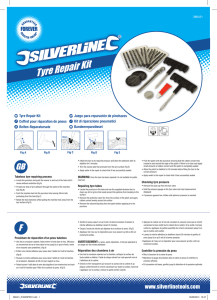
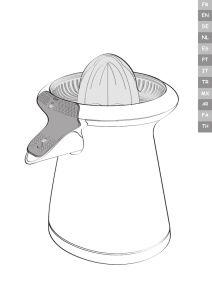
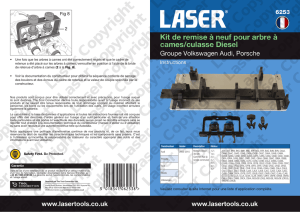
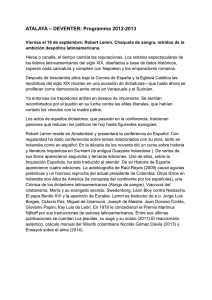

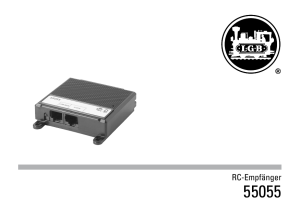
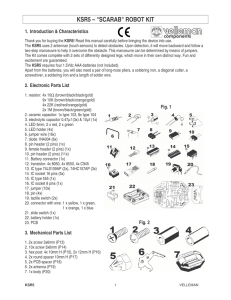
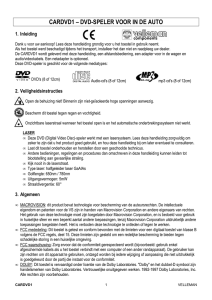
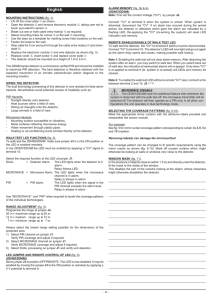
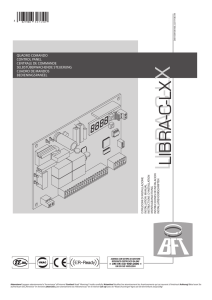
![2 [es] - Documentación técnica](http://s2.studylib.es/store/data/007695753_1-b0de67d7f1af86040d299cb1e943bfd2-300x300.png)